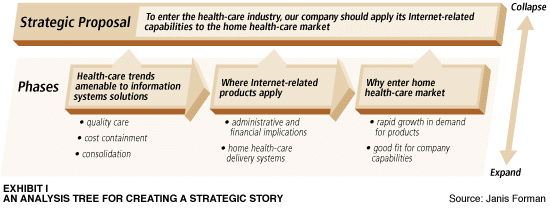When Stories Create an Organization
Communications are suffering from an overemphasis on graphics and multimedia that are turning boardrooms into video-game parlors. Learn the art of storytelling to get your agenda across.
 Clear communication between executives and their audiences has been declining ever since the advent of souped-up computer graphics and Internet access to vast quantities of data. The blessings of computer technology notwithstanding, anyone observing a high-level business presentation in today's networked buildings is likely to feel overwhelmed by the sheer tonnage of charts and graphs that rush across a computer screen at a pace that outstrips human capacity for comprehension.
Clear communication between executives and their audiences has been declining ever since the advent of souped-up computer graphics and Internet access to vast quantities of data. The blessings of computer technology notwithstanding, anyone observing a high-level business presentation in today's networked buildings is likely to feel overwhelmed by the sheer tonnage of charts and graphs that rush across a computer screen at a pace that outstrips human capacity for comprehension.
In this 21st-century setting, the presenter often stands off to the side looking like a Nintendo player clicking rapidly from one multicolored graphic to the next and commenting briefly on the slides that dominate and drive the presentation. Meanwhile, the members of the audience are dazed onlookers to the "game," wondering what, if anything, the bits and pieces of data and analysis mean.
Yet, data and analysis must make sense if executives' agendas are to be heard and supported in the highly charged arenas that have come to be known as "normal" organizational life. The most important agendas are those that create an organization's strategic reality, its long-term future direction. One successful approach an executive can use to get the attention of important stakeholders is to tell stories that capture their interest and gain their support.
It has long been known that storytelling is a powerful means of persuasion, although it may have been temporarily lost in our age of information overload (in which strategic presentations are often little more than a data dump, a mind-numbing accumulation of facts, numbers and models devoid of logical arrangement and interpretation). The Greeks, who introduced Western culture to the "art of persuasion" through Aristotle's book on rhetoric, knew - as early as Homer's "Iliad" - that storytelling can celebrate a nation's past and create a sense of community among those who listen to the tale.
Organizations have begun to use this community-building quality of stories, celebrating an organization's founding or its major breakthroughs in ceremonial speeches by the chief executive officer or in more broad-based and ambitious organizational histories. Imagining and depicting an organization's future in story form is yet another powerful function for stories. When successful, strategic stories are an executive's way to convince his or her audience to "picture this future for the organization; find it compelling and achievable, and support its enactment."
Rather than the stuff of legend, "story" in this context means an argument for a particular vision of an organization's future, an argument that makes sense for two reasons: 1) the beginning of the story leads to the middle and it, in turn, leads to the end, and the order of events has a kind of inevitability, and 2) in each phase of the story, the executive forges powerful links between the strategic reality he or she advocates and the data that support it.
CREATING AN ANALYSIS TREE
One device that executives can use successfully to develop or test the coherence of their stories and the evidence to support their ideas is an analysis tree. (See Exhibit I.)

An analysis tree is a visual metaphor that shows the relationships among the phases of the story (the beginning, middle and end) as well as the top-down structure of ideas, that is, the links between the strategic reality that is advocated (the top branch of the tree) and the phases of the story (the lower branches of the tree).
Exhibit I shows an analysis tree that an executive created to organize his strategic story about his company's need to expand into the home health-care market. The high-tech company he works for specializes in Internet-related products but has not yet considered a move into the health-care industry. The new strategic reality that the executive advocates appears as the top branch of his analysis tree: "To enter the health-care industry, our company should apply its Internet-related capabilities to the home health-care market." He devotes the opening phase of his story (the second-level left branch) to important current trends in the health-care industry that are amenable to information-systems solutions.
These trends include the industry's concern for quality of care and cost containment as well as the growing consolidation of health-care providers. In the second phase of his story (the second-level middle branch), he focuses on how Internet-related products can take advantage of the trends in health care, namely, in administrative and financial applications and in home health-care delivery systems.
In the third and final phase of his story (the second-level right branch), he makes a case for the company entering the home health-care market first by showing the relative maturity of information technology applications for the administrative and financial needs of the industry and then by identifying the rapid growth of the home health-care market and the good fit between the market's needs and the company's capabilities.
The analysis tree has helped this executive create and then see his story line - from the trends in health care to the potential entry of his company into a specific segment of the market. The supporting information for each phase of the story appears under each of the respective branches. So, for instance, health-care quality, cost containment and industry consolidation appear under the left branch as "smaller branches." The analysis tree also helps determine what to include in, and what to exclude from, the story. Anything that advances the story or supports one of the main branches should be included; anything else should not.
Another advantage of the analysis tree is its usefulness in helping managers develop flexibility in their storytelling. No single version of the strategic story fits all stakeholders. The tree can be expanded or contracted readily to suit the storyteller's assessment of which version is most appropriate for each constituency he wants to address. So, for example, a five-minute session with the chief executive officer might focus exclusively on top-level issues: health-care trends, potential Internet applications and the relative desirability of entering the home health-care market. A longer discussion with managers unfamiliar with health care might provide a detailed picture of trends in the health-care industry. A memo or talk to the research and development unit might focus on specific Internet applications for the market.
BEYOND MAKING SENSE
Besides coherence and flexibility, strategic stories need to gain and hold stakeholders' attention in an environment plagued by numerous competing demands. Powerful strategic stories are narratives of exigency. The urgency of events and circumstances and the need for timely response at a strategic level are built into all phases of these stories.
The executive in the high-tech company shows that the health-care trends he describes - the importance of high quality, cost containment and industry consolidation - are the industry configuration that makes information-technology solutions of a particular kind very attractive now; that there is an opening for Internet-based solutions for home health-care delivery now; that there are very few competitors in the industry now. He demonstrates that the "open moment" is now and that failure to respond now means missing the opportunity.
The language of a strategic story can also contribute to both its sense of urgency and the degree of acceptance that it receives. A strategic story that incorporates the language representing people's shared experience of the organization's core values is likely to be a story that is heard. For instance, Johnson & Johnson's credo is such a living language - a language frequently discussed at all levels of the organization and shared as a published statement of the company's mission.
A living language can be used effectively in the company's strategic stories to marshal support for action, including, in the case of Johnson & Johnson, the company's response to the Tylenol poisonings in the 1980's. On the other hand, language devoid of meaning to significant stakeholders can derail a strategic story.
Take the example of an automobile company that tried to revise its strategy through evoking the concept of "re-engineering," a buzzword that was hastily imported into the company without explanation or discussion. The unassimilated term and the new strategic story were introduced in a vacuum and never took root with any stakeholders. When used in a strategic story, "empty" language, such as the latest jargon superficially acquired from the consulting or academic world, is likely to result in anger and distrust rather than acceptance. And the language may eventually pass away.
AUDIENCE AS PARTICIPANT
Rather than admiring spectators, the audiences for stories about strategy are judges ready to weigh a story against their own knowledge and opinions about the best strategic reality for the company. Because an audience scrutinizes a strategic story, the storyteller must try to anticipate likely objections to the new strategic reality she champions and to plan her responses, including them in the story itself or offering them when the audience challenges her.
The audiences most willing to listen to a strategic story have a hand in formulating it, feel listened to and recognize that their concerns and even their language are incorporated in the story. Yet, despite the best preparation, stories told about a proposed strategy are routinely "broken into" by stakeholders. Therefore, on those occasions when an executive offers her story, she should be a good "reader" of her audience's reactions and make adjustments to them.
This was the case for a senior manager at a construction company during her presentation of a new strategic initiative to the chief executive officer. The manager quickly judged that the chief executive officer would not listen to her story about "evolutionary change" for the company (to encompass everything from engineering to marketing) because she had failed to take into account the chief executive officer's favorite mantra for strategic change - "creative partnering" with selected companies to establish the optimal mix of plant and personnel for their large construction projects. Once the presenter integrated "partnering" into her story, the chief executive officer listened and responded favorably to her approach.
Even with a thorough stakeholder analysis, storytellers can be taken off guard because today's audiences are often ambiguous and transient. The person a manager pitches a story to today may move on to a new job tomorrow or may develop different concerns. Strategic issues that were at the top of the organization's list today may be gone tomorrow.
Since an organization's strategic reality can shift rapidly, the best an executive can do is to create stories that have a kind of "semi-permeable membrane," that is, an openness to the past (earlier discussions about key strategic issues among significant stakeholders) and an openness to the future (predictable responses by key stakeholders). ![]()
Reprint No. 99201


